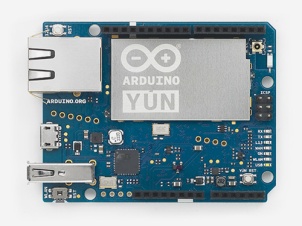
The Arduino Yún is the most powerful board Arduino has made, with a staggering 400 MHz processor as well as the typical Arduino microcontroller processor. It combines the ease of use of Arduino with the power you have with the Linux operating system, creating a unique product that stands out in the Arduino lineup. This thing is a powerful tool and perfect for Internet of Things projects, but is it worth the incredibly high price of $55 when you can pick up a Raspberry Pi Zero for just $5? Let’s find out!
Design
The board itself is no larger than the Arduino Uno, 2.7 inches long and 2.1 inches wide. This is impressive in my opinion considering how much extra stuff is on the Yún. It has a standard USB port allowing the connection of USB enabled devices such as webcams, memory sticks, or joypads. It has a 10/100 Mbit/s Fast Ethernet port in case you do not want to use the 2.4GHz on-board WiFi. Replacing the incredibly large previous power connections is a single micro-USB connection (the same one as most smartphones use). This is a much more practical solution to powering the board than previous boards use. As well as being able to power it with a micro-USB, you can use the Vin pin or the optional Power Over Ethernet (POE) module. However, you must be very careful when using the Vin pin, as there is no voltage regulator. It has to be a 5V DC power supply.
Specs
Compared to other Arduino products such as the Arduino Uno, Mega, and Duemilanove, this thing sure is powerful. It has 2 microprocessors on board, one for running Linux and one for the I/O pins and the electronics prototyping side of it. The Linux processor can only be accessed via WiFi or ethernet, or via the bridge, whereas the other processor can be accessed, as normal, through the Arduino IDE via a USB cable. The bridge library allows the two processors to communicate with each other, which makes them in a way, act as one.
The processor powering the Linux, the Atheros AR9331, clock speed of 400 MHz, which is fully capable of an y non-GUI command-line operating system such as Linux. This is about equivalent to the old Pentium II which ran Windows XP with no problem (not that you’d be running XP on an Arduino).
y non-GUI command-line operating system such as Linux. This is about equivalent to the old Pentium II which ran Windows XP with no problem (not that you’d be running XP on an Arduino).
The board has 62 MB of DDR2 memory which is less than I would have expected but still enough not to cause any issues.
The microcontroller to run the electronics side of things is the ATmega32U4, a slight improvement over the typical ATmega328P microcontroller in the Arduino Uno. However, these are very similar so you would expect it to work pretty much the same as the Uno or any other standard Arduino board.
However, it does have an extra 4 digital I/O pins which are nice, one of those being PWM (Pulse Width Modulation).
Overall, the Yún has an incredibly powerful processor for running Linux and an improvement over the standard ATmega328P chip on the Uno.It is able to run complex applications over the internet without really processing the chip, which gives the Yún an edge over any other Arduino product simply because it’s so different and there’s so much more that you can do as a result of that.
The Linux Processor
| Processor | Atheros AR9331 |
| Architecture | MIPS |
| Operating Voltage | 3.3V |
| Ethernet | 802.3 10/100Mbit/s |
| WiFi | 802.11b/g/n 2.4 GHz |
| USB Type | 2.0 Host |
| Card Reader | Micro-SD |
| RAM | 64 MB DDR2 |
| Flash Memory | 16 MB |
| SRAM | 2.5 KB |
| EEPROM | 1 KB |
| Clock Speed | 400 MHz |
The Microcontroller
| Microcontroller | ATmega32U4 |
| Operating Voltage | 5V |
| Input Voltage | 5 V |
| Digital I/O Pins | 20 |
| PWM Output | 7 |
| Analog I/O Pins | 12 |
| DC Current per I/O Pin | 40 mA on I/O Pins; 50 mA on 3,3 Pin |
| Flash Memory | 32 KB (of which 4 KB used by bootloader) |
| SRAM | 2.5 KB |
| EEPROM | 1 KB |
| Clock Speed | 16 MHz |
Connectivity
One of the things that Arduino is criticized for is it’s lack of connectivity; however, the Yún solves that completely. With onboard WiFi and a port for Ethernet, you will no longer have to attach a bulky ethernet shield to connect your Arduino to the internet. It takes about 10 minutes to get the Yún connected, and then you can operate your entire project wirelessly.
The Yún can also work as an Access Point, meaning multiple devices are able to connect to Yún directly. In this mode the Yún is not able to connect to WiFi itself, however, this could still be a very useful tool if, for example, you were using a group of WiFi enabled sensors.
One thing that I massively like about the Yún is that you can actually upload sketches to the board wirelessly. After first configuring the board, the Yún should be listed in the Arduino IDE even without connecting it with a wire. If it doesn’t show up then you can upload your sketch using the Arduino Yún web app, below.
upload sketches to the board wirelessly. After first configuring the board, the Yún should be listed in the Arduino IDE even without connecting it with a wire. If it doesn’t show up then you can upload your sketch using the Arduino Yún web app, below.
To make things even better, Arduino has partnered with Temboo to add extra functionality to the Yún. Temboo is a service which gives access to popular APIs. A Temboo library comes with the Yún, making it easy to connect to a large variety of online tools and develop applications that can connect to popular web services.
Software
The board co mes pre-installed with a version of Linux that it supports – the LininoOS. It is however recommended on their website to put a version of this operating system on a micro-sd card and use that instead of the pre-installed version because the pre-installed version has a ‘limited number of writes’. I’m not exactly sure what they mean by that, but I would recommend putting it on a micro-sd simply because it will make sure you are using the most up to date version of Lilino-OS.
mes pre-installed with a version of Linux that it supports – the LininoOS. It is however recommended on their website to put a version of this operating system on a micro-sd card and use that instead of the pre-installed version because the pre-installed version has a ‘limited number of writes’. I’m not exactly sure what they mean by that, but I would recommend putting it on a micro-sd simply because it will make sure you are using the most up to date version of Lilino-OS.
Upon first setup of the Yún, you are greeted by a welcome
page and you can sign in to your board with the default password ‘Arduino’. You can then give your Arduino a name and set your own password for logging in. From here you can also configure your wireless network.
It is also possible to upload sketches to it through the web app.
Conclusion
In conclusion, I think that this is an incredibly powerful tool for the Internet of Things, and pretty much the only Arduino board fully capable of running CPU intensive applications over the internet. The extra functionality with Temboo means that there are now hundreds more projects now possible with Arduino. So, despite the very high price, this board is worth it for any hobbyist who wants to operate projects over the internet and I think this board will stand out in the Arduino lineup for years to come.
Compared to any Raspberry Pi this thing is weaker and more expensive, however when you buy an Arduino product you support the development of open source hardware. Also, I would buy this over the Pi equivalent simply because I prefer the Arduino platform for electronics prototyping over the Raspberry Pi platform. I wouldn’t buy an Arduino or Raspberry Pi to use as a desktop computer, I would buy one for building electronics projects which I think the Arduino does a better job of. So for me, it is worth it, simply because it combines the incredibly powerful Linux operating system with the Arduino electronics platform we all know and love.
Buy from Amazon

But…You never came to a conclusion about whether or not a Pi is better value for $
LikeLike
Yeah I did skip that out… Going to edit it.
LikeLike
I’ve updated the post with an extra paragraph about why I would buy this over a Pi. Thanks for your suggestion.
LikeLike
Pingback: Arduino Yún Review — Pi and Chips | boltspinner2
I like the combination of both worlds and think it will allow a who new wave of projects to unfold. I think though the price mark has put it out of reach of the next generation of young programmers. With UK schools now having put computing back on the curriculum again and the students knowing more than the teachers because it’s all been missing from their education these students are tomorrows future of computing and its these who it should be aimed at.
A price mark of £25 (30$ ish) would have been better. It might even have generated sales as at its current price mark its something to think about and have to convince to spend the money when it’s less it’s in the range of an impulse buy. Only when they get it home do they realise what a great product it is.
LikeLike
I totally agree – if this board was priced more reasonably it would be much better selling. That’s why I wrote this review, to encourage people to buy it. It’s such an amazing IOT device that people are missing out on.
LikeLike
IOT is better handled with a pi as compared to an arduino. I’ve been working with an arduino for the past one year but I will still say pi3 beats them all.
Do check out the basic projects on my site – http://www.electromaniaweb.wordpress.com
LikeLike
Yes, you can do more with the Pi 3, but I just prefer doing electronics with Arduino. It’s easier to prototype electronics with in my opinion . It also uses my preferred programming language which is one of the main reasons I go with Arduino.
LikeLiked by 1 person
How much does it cost?
LikeLike
Around £55 for the full size model, maybe slightly less for the mini version. Very expensive compared to the Pi 3, however entirely worth it in my opinion.
LikeLike